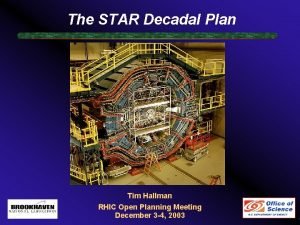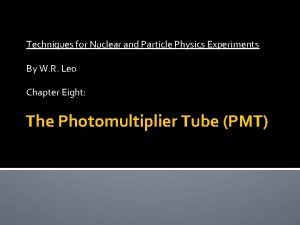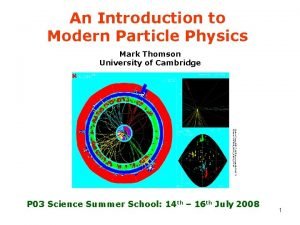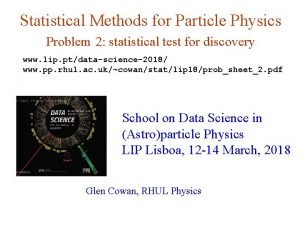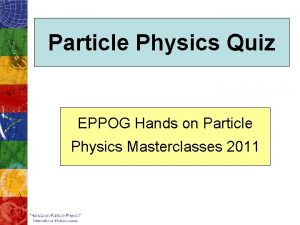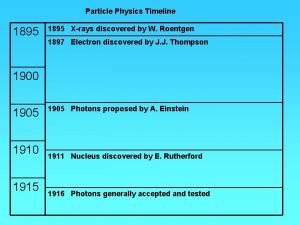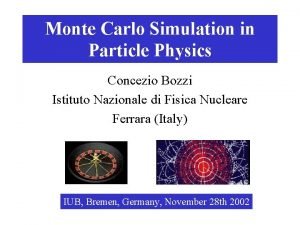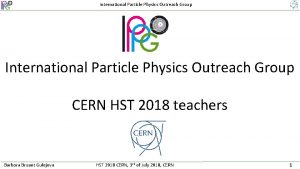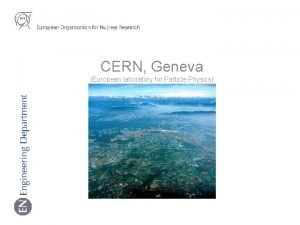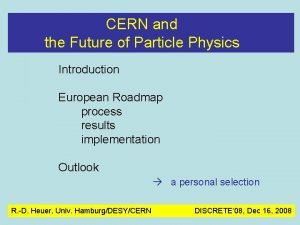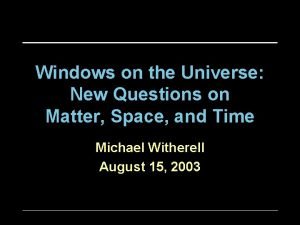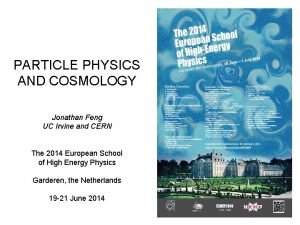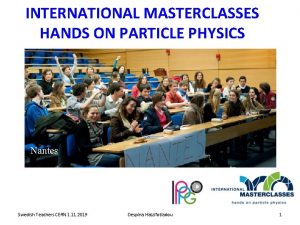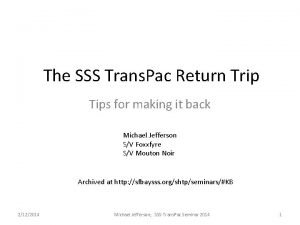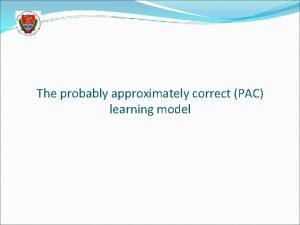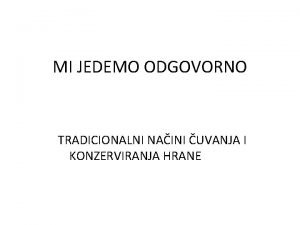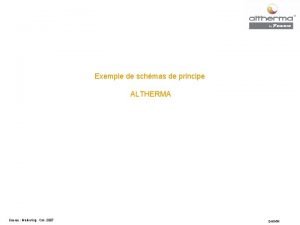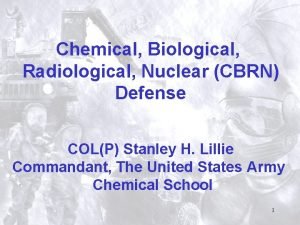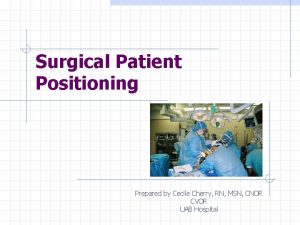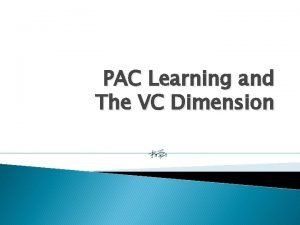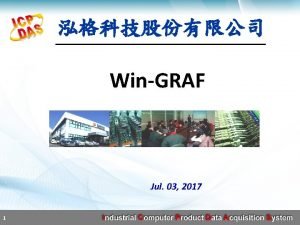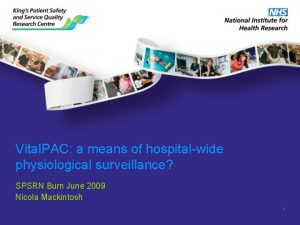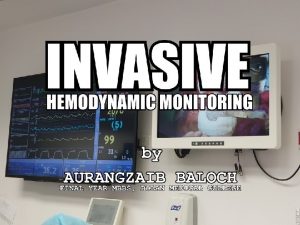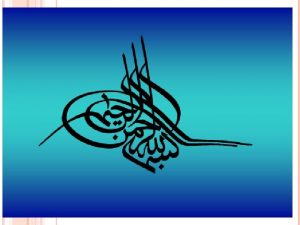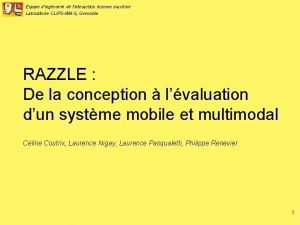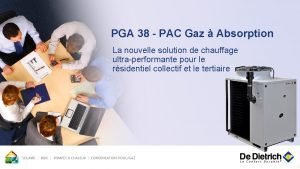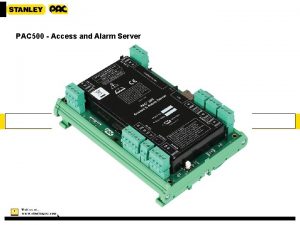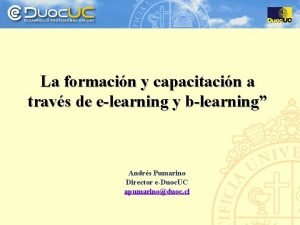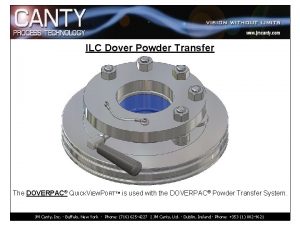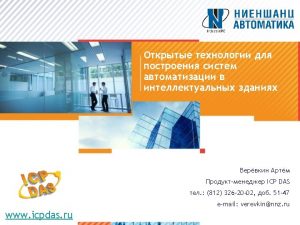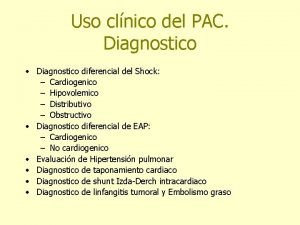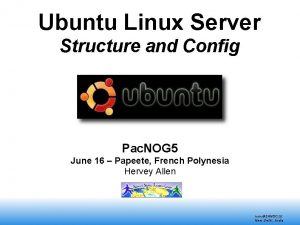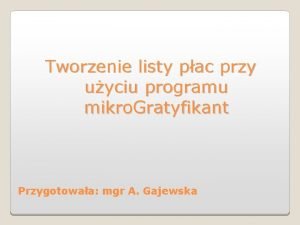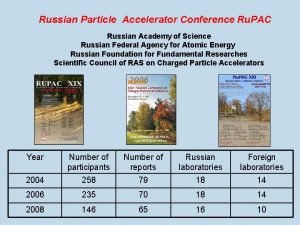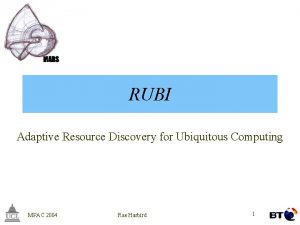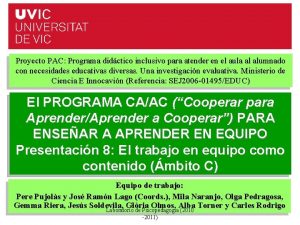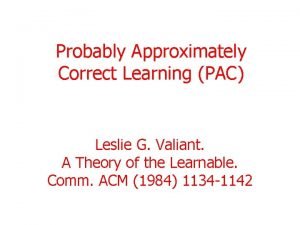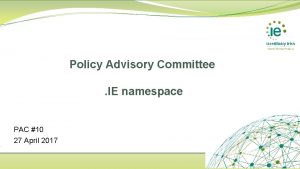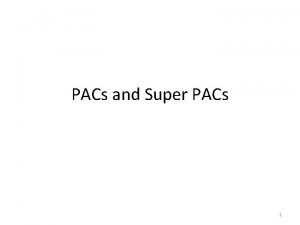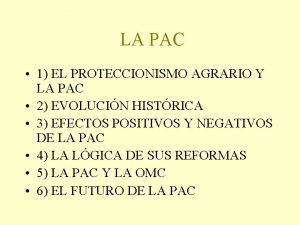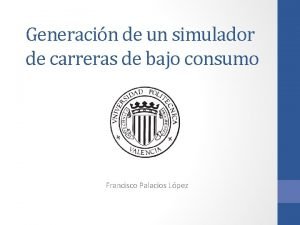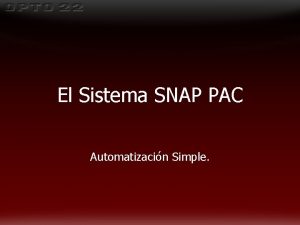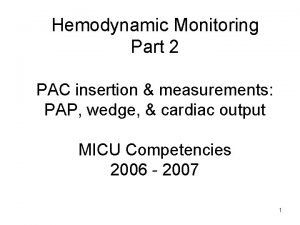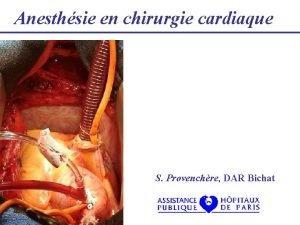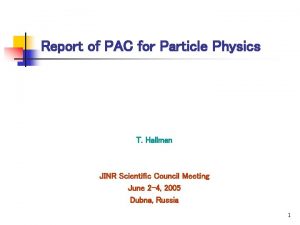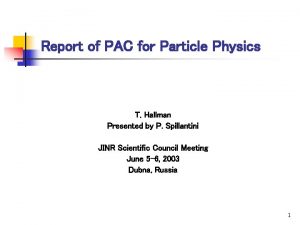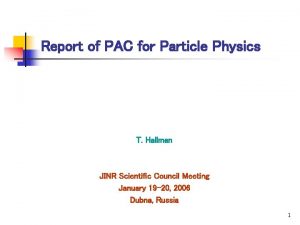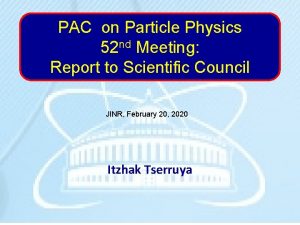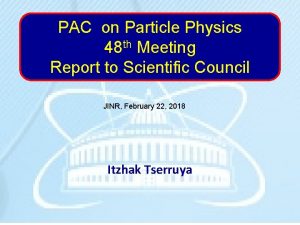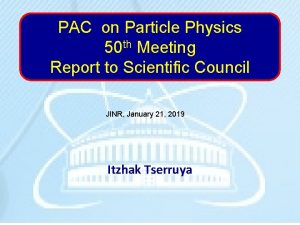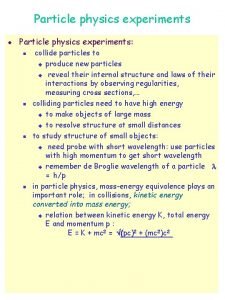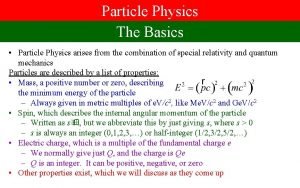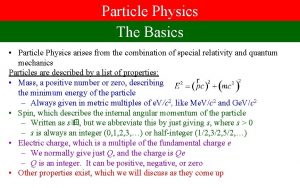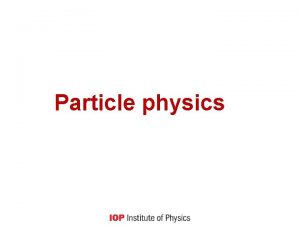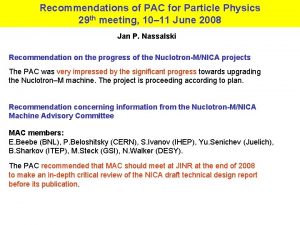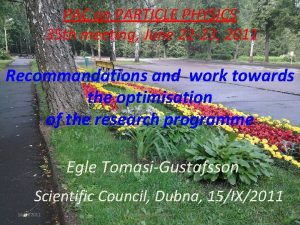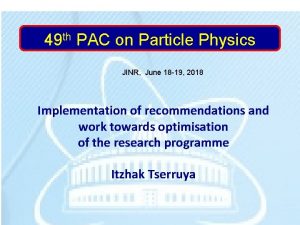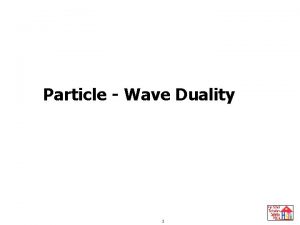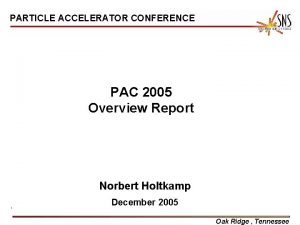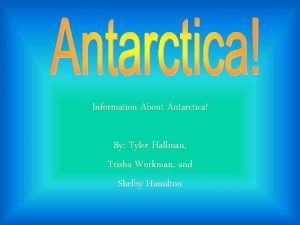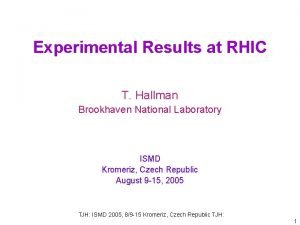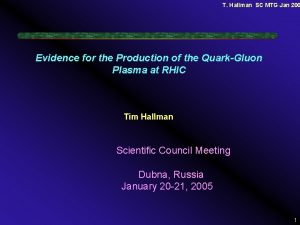Report of PAC for Particle Physics T Hallman





































































- Slides: 69

Report of PAC for Particle Physics T. Hallman JINR Scientific Council Meeting January 18 -19, 2006 Dubna, Russia 1

Preparation of the JINR Programme of Particle Physics Research for 2007 - 2009 in line with the main Provisions of the Road Map In the past year the central directorate and the directorates of laboratories aspired to bring to conformity the Research plans with the JINR Road map and to concentrate our limited resources on the most perspective themes and Projects – R. Lednicky Funding in k$ (materials, equipments, visits) n n n n n n Info+Comp+Network (V. Ivanov, V. Korenkov, P. Zrelov) ATLAS (N. Russakovich) CMS (A. Zarubin, I. Golutvin*) NA 58/HERMES (A. Nagaitsev, I. Savin*) GIBS+ 2+NA 49+LNS+p. He 3+PHENIX+ Nucl+BECQ (A. Malakhov) NA 48/H 1/Okapi (V. Kekelidze) OPERA (Yu. Gornushkin) STAR (R. Lednicky, Yu. Panebratsev) CDF+D 0 (G. Alekseev, J. Budagov, N. Giokaris) ALICE (A. Vodopianov) DIRAC (L. Afanasyev, L. Nemenov*) Rare Processes (A. Kirilin) HADES (A. Malakhov, Yu. Zanevsky) STRELA+ +ALPOM+PPM (N. Piskunov, G. Martinska) NIS (E. Strokovsky, A. Litvinenko) MARUSYA (A. Baldin) FAIR-GSI (A. Sissakian) LHC Damper (V. Zhabitsky) NUCLOTRON (A. Sissakian, A. Sorin, A. Kovalenko) MED-NUCLOTRON (N. Agapov, N. Krasavin, G. Mytsin, J. Ruzicka) ILC Phys+Det (A. Olshevski) ILC: Accelerator Physics and Engineering (A. Sissakian, G. Shirkov) * Scientific leader ** Including funding under the JINR-BMBF Agreement 07/07 -09 240/ 901 414/1479 320/ 955 145/ 420 135/ 465 115/ 375 110/ 330 72/ 269 72/ 216 60/ 180 58/ 174 53/ 159 35/ 115 34/ 107 27/ 124 21/ 101 217/ 644** 30/ 110 1140/ 5076 30/ 90 110/ 349 145/ 459** 2 +352/ 2512 n-b

New approach to the Topical Plan of Research of the JINR -N. Russakovich Reasons for improvements n n The Topical Plan has been significantly overloaded last years. Too many topics have been recommended for implementation by PAC’s and Scientific Council, mainly due to the absence of clear guidance from budgetary limitations (56 topics in total). This resulted in chronic under-financing of some projects and consequently to decreasing the realization of those projects and/or continuous extension of their “lifetime” The “traditional” Topical Plan, although been updated on the yearly basis, doesn’t contain clear “milestones” which could be followed up, even in the event all resources requested are provided in due time Substantial part of the budget (about 0. 8 M$) has been (and still is) allocated every year as “Grants of Plenipotentiaries” of Member States and “Joint Programs” between JINR and Member States, which leads in reality to a more or less “flat” distribution of those resources between topics, with no strong correlation with the priorities established by the PAC’s and the SC Continuous deficit of resources motivated some JINR’s researchers to 3

Guidance's from JINR directorate to Laboratories Directorates and Project Leaders n n The assessment of the significance of research themes and projects should be based on the strategic plan (road map) of JINR’s development. The topical plan should include only those themes and projects, which can be fully financed in a timely way from the JINR budget. A 3 -year plan of research, including clear milestones, will be required for each theme/project. Also the 3 -years cost profiles, coordinated with collaborating organizations, are obligatory. 4

Guidance's from JINR directorate to Laboratories Directorates and Project Leaders (2) n Research projects with a small number of participants from JINR (less than 5 “full-time equivalent”/FTE) and/or with a low level of financing from the JINR budget (less than 5 KUSD/FTE per year) as a rule, would not be included to the Topical Plan. n The Directors of the Institute Laboratories will be given the opportunity to use up to 10% of their respective laboratory budget under the corresponding budgetary items for supporting low-cost activities of promising nature, with a simplified procedure for the approval of projects. “Merging” of several projects in order to reduce the (total) number of projects in the Topical Plan is not accepted. 5

Guidance's from JINR directorate to Laboratories Directorates and Project Leaders (3) n n n Projects of construction (upgrade) of basic facilities should be submitted in the form of schedules indicating the scope of work, terms of execution and cost estimates. In planning several options for such projects, the assumed decision-making points should be emphasized. The exploitation costs are specified in a separate category. The administrative and financial management of themes and projects by persons after reaching 65 years of age will not be allowable beginning 2007. The support of innovative projects from the JINR budget is allowable for a term of not more than one year; subsequently these can only be financed from non-budgetary sources. 6

A comment by the PAC on the Directorate’s continuing effort to streamline the JINR particle physics program n n JINR Chief Scientific Secretary, N. Russakovich, informed the PAC about the Directorate’s intention to implement a new approach to the contents and the template of the JINR Topical Plan of Research and International Cooperation. This approach, based on three-year planning, is intended to be fully consistent with the actual limitations of the JINR budget. The PAC congratulates the JINR Directorate on progress made towards streamlining the particle physics program of the Laboratory an on establishing milestones against which progress can be tracked each year. 7

ATLAS (JINR’s participation) Accounted JINR’s contribution to ATLAS by the end of 2005 is about 96% of JINR’s commitment of 8. 2 MCHF The main tasks of the The Hadron Barrel Calorimeter was JINR muon group connected with positioned at its final destination, chambers assembling, testing and with significant contribution installation in ATLAS BMF/BMS from the JINR ATLAS team. were successfully completed. The mechanical installation is complete, electrical and cryogenic connections and testing is being made now. Installation of barrel muon station 8

CMS (JINR’s participation) Accounted JINR’s contribution to CMS by the end of 2005 is about 97% of JINR’s commitment of 13. 3 MCHF Assembly of hadron endcap calorimeters n n Test of readout system before installation on detector Installation of readout systems on detector Test of installed readout system Radioactive source calibration Hadron endcap calorimeter with installed readout system The main interest of JINR and RDMS physicists is focusing on physics beyond the Standard Model at dimuon masses in Te. V-range 9

ALICE (JINR’s participation) Accounted JINR’s contribution to ALICE by the end of 2005 is about 80% of JINR’s commitment of 2. 5 MCHF plans for 2006 -2008 Dipole Magnet was disassembled and then successfully assembled in the operational position. It was tested & mapped at full current. n n n n Delivery of 330 of Pb. WO crystals (200 in 2006); Test of 1000 crystals using the spectrophotometer; Construction of 40 drift chambers for TRD; Preparation of Physics Performance Report vol. II; Further development and tests of GRID computing. Commissioning of the ALICE detector; Beginning of data taking; Start of the data analysis. 10

Network for Physics 11

PAC Chair’s comment n n n The physical construction for the LHC carried out by JINR has been a stunning success It is time now to turn to science-that is happening for the ATLAS, CMS, and ALICE teams Lingering concern over whether the computing infrastructure is scoped sufficiently to allow robust program of remote scientific analysis 12

Recommendations on Major Future Projects Facility for Anti-proton and Ion Research (FAIR) 13

Plans for JINR participation in the physics research at FAIR JINR interests at GSI: ● Accelerator Physics ● Nuclear Matter ● Physics with Antiprotons ● Applications JINR Contributions: ● Magnets of SIS 100 ● CBM Experiment ● PANDA experiment ● PAX 15. 09. 2021 A. Olchevski, PAC PP 14

Development of new superconducting magnets for rapid cycling heavy-ion synchrotrons and beam transport channels (A. Kovalenko) Superferric 1 Hz dipole and quadrupole magnets View of the SIS 100 prototype dipole and quadrupole magnets. The works are performed within the R&D program on the design the SIS 100 synchrotron at GSI in Darmstadt. The investigations of 2 T superferric 1. 4 m model dipoles operating at 4 T/s, 1 Hz were completed. The main research goal, namely: minimization of overall AC power losses in the magnet at 4 K level was reached. The AC losses were reduced by a factor of two for both as dipole and quadrupole magnets. The new stage of the JINR/GSI collaborative work is construction of a full length dipole (about 3 m ) and quadrupole (about 1. 1 m) with the SIS 100 specified apertures. The work is in progress. The results were presented at the EPAC’ 06 and ASC’ 06 Conferences. Artistic view of the new magnets inside cryostats is presented in Fig. 15

Compressed Barionic Matter (CBM) (A. Malakhov) JINR participation: Transition Radiation Detector (TRD) Straw Transition Radiation Tracker (TRT) Superconducting Dipole Magnet Simulation (tracking, RICH, magnetic field) Physics The NUCLOTRON was used as a test bench for CBM detectors 16

LIT group activity for CBM (V. Ivanov) Problems arisen due What has been done to two future 1. Flexible tracking software developed alternative CBM for studying features of both STS-MVD projects: electron or designs. Momentum evaluation gives 1% muon physics level of accuracy n n New magnet design Software development for STS and TRD tracking n n n Tracking for new design of STS and MVD: two versions Tracking for TRD: two versions STS based (STS TRD) and standalone RICH ring-finding n n n Problem of effective rejection of fake and clone rings (2 D parameter cuts, neural network approach) Study of two alternative RICH constructions based on: Protvino photomultipliers (40 hits/ring) or Hamamatsu photomultipliers (22 hits/ring) RICH ring fitting and electronpion separation 2. Two versions of TRD tracking developed: STS based and standalone An original TRD 10 layers (4 -3 -3) design was proposed which looks most optimal for both versions. Efficiency for standalone tracking One of advantages of the Kalman filter based tracking algorithms is that they are easy adaptable to various STS and TRD designs 17

LIT group activity for CBM (continue) 3. RICH ring-finding 7 different parameters were taken into account to characterize any found ring and applied for effective rejection of fake and clone rings. Comparative study of two approaches: 2 D parameter cuts or neural networks (NN) showed the NN method advantage. Its efficiency to reject fake and clone rings is 90%. However despite of a few percent loss in efficiency for electrons the gain is: 17 times less fake rings and 6 times less clone rings NN output Study of two alternative RICH multiplier constructions: Hamamatsu yield to Protvino only 10% in efficiency, but gives less fake rings and no clones 4. Ring fitting and e -π separation After comparison of several ring fitting algorithms the best one was put into CBM framework. Neural net was successfully applied for most effective suppression of the pion rate 18

PANDA ● Excited glue (glueballs and hybrids) ● Charm in Nuclei, Charmonium ● Hadrons in Matter ● Hypernuclei, etc. Present involvement: Magnet System Dubna is also working on new physics subjects, in particular, “Lepton pair production in ppbar collisions” MDC Muon System RICH and DIRC + new subjects: PANDA computing framework and beam parameters simulation 19

Project PAX Collaboration PAX proposed experiments with polarized antiprotons. For this purpose a dedicated facility at FAIR to polarize an antiproton beam could be built. Scientific program: studies in the field of high energy spin physics with use of a polarized antiproton beam Main goal: measurement of the transversity distribution, the last missing piece of the QCD description of partonic structure of the nucleon. Transversity describes distribution of transversely polarized quarks inside the transversely polarized nucleon. Unlike the well-known unpolarized distribution q(x, Q 2) and partly known helicity distribution Dq(x, Q 2), transversity hq 1(x, Q 2) has never been directly measured. Transversity distribution is directly accessible uniquely via the double transverse spin asymmetry ATT in the Drell-Yan production of lepton pairs: phph g l+l-X Other topics: electromagnetic form factors (phases in the timelike region, G E-GM separation, …) single-spin asymmetries (Sivers and Collins mechanisms, …) p-pbar hard scattering mechanisms 20

Recommendations on Major Future Projects Facility for Anti-proton and Ion Research (FAIR) n n n The PAC considers this activity very important for JINR’s future particle physics program With the process now ready to begin to determine JINR’s real participation in the construction, it is very important to insure that all aspects of JINR’s activity will have high scientific visbility and impact. This may well require concentrating available resources on selected aspects of FAIR as opposed to participating broadly in all areas of interest. The PAC looks forward to receiving additional information on the main areas of scientific activity at 21

Recommendations on Major Future Projects International Linear Collider (ILC) 22

23

ILC siting and conventional facilities in Dubna region Joint Institute for Nuclear Research Dubna, Russia International Intergovernmental Organization 24

Dubna Siting: Layout of ILC in the Moscow Region Tver region Moscow region 25

The ILC linear accelerator is proposed to be placed in the drift clay at the depth of 20 m (at the mark of 100. 00 m) with the idea that below the tunnel there should be impermeable soil preventing from the underlying groundwater inrush. It is possible to construct tunnels of the accelerating complex using tunnel shields with a simultaneous wall timbering by tubing or falsework concreting. Standard tunnel shields in the drift clay provide for daily speed of the drilling progress specified by the Project of the accelerator (it is needed for tunnel approximately 2. 5 y’s). 26

Advantages of the ILC construction in Dubna: 1. The presence of JINR as a basic scientific and organizational structure. JINR is an international intergovernmental organization, which includes 18 Member States and 4 States, which are associated members. 2. The proposed territory is extremely thinly populated and practically free of industrial structures, rivers and roads. The proposed placement of the accelerator tunnels in relatively drift clay excludes the influence on abyssal distribution of the underwater. 3. The area is absolutely steady seismically and has stable geological characteristics. 4. A flat relief and the unique geological conditions allow one to place ILC on a small depth (about 20 m) and to perform construction of tunnels, experimental halls and other underground objects with the least expenses, including open working. 5. The extremely attractive feature of placing the ILC complex on the chosen territory is a unique opportunity to solve the problem of value at the purchase of land. Prevalent legal practice makes it possible to get the land of the ILC location to permanent free use just as it has been done for JINR, according to the agreement between JINR and the RF government. 27

6. There are sources of the electric power of sufficient capacity in the area of the ILC construction: transmission line of 500 k. V, the Konakovo electric power station (EPS) and the Udomlia atomic power plant (APP). 7. The developed system of transport and communication services, advantageous location, good highways and railways, water-way (the Volga river basin), good position in the European region; 8. Presence of a modern network and information infrastructure, including one of the largest center in Europe the “Dubna” Satellite Communication Center. 9. A special the economic zone established in Dubna in December, 2005 provides preferential terms for development and manufacture of high technology technical production. 10. Dubna has a powerful scientific and technical potential. The developed infrastructure makes it possible to involve additionally specialists from world scientific centers into the already formed international collective of highlyqualified scientific manpower providing comfortable conditions for them to work. This guarantees a high quality of investigations on ILC and obtaining of new research results of fundamental scientific importance. 28

Chronology of JINR in ILC December 2005 – GDE in Frascati – A. N. Sissakian with first proposals from JINR to be involved into global accelerator project and Dubna siting; January 2006 – a special workgroup on ILC was created at JINR January 2006 – JINR Scientific Council encourages JINR to be involved in the ILC design effort and supports the intention of JINR to participate in the ILC project and the possible interest of JINR to host the ILC March 2006 – JINR Committee of Plenipotentiaries approved SC recommendation; March 2006 – visit of European GDE director Prof. B. Foster to Dubna; May 2006 – European GDE in DESY - Detailed information from JINR as from sample site; July 2006 – GDE in Vancouver – Documentation from JINR to BCD with RSPI estimation on CFS (Site Assessment Matrix); November 2006 – GDE in Valencia – Documentation from JINR to RDR with new RSPI estimation on CFS (Work Breakdown Structure) officially submitted. Participation of JINR representative in a GDE Directorate round table; JINR (Dubna) is officially approved by GDE Director as sample site for ILC hosting. RDR will include information about Dubna sample site. 29 Detailed Cost Estimation on subsystems from JINR will be in TDR.

In Frascati Prof. A. Wagner at LINAC-800 Prof. B. Foster in Dubna Round table in Valencia 30

Preparation of proposals for JINR participation in design, manufacturing and testing of the Linear Collider element prototypes Theme leaders: A. N. Sissakian G. D. Shirkov Period: 2007 - 2009 Expected results in 2007: -Preparation of works of JINR; - Participation in estimations and design of ILC elements 31

Laboratory Person in charge at the Laboratory Key executors and number of participants Elaboration of photoinjector prototype (DLNP, LPP) Calculation of electron beam dynamics in the injector (DLNP) I. N. Meshkov, G. V. Trubnikov Meshkov I. N. + 8, Tyutyunnikov S. I. , Kobets V. V. + 3. The LINAC-800 based test-bench; FEL on the base of LINAC-800; photoinjector; Development of the RF system elements Development of diagnostic, Development of inside devices LPP, DLNP G. D. Shirkov, N. I. Balalykin, A. I. Sidorov E. M. Syresin N. I. Balalykin, Kobetz V. V. + 3, A. I. Sidorov + 2 E. M. Syresin + 4. Metrological laser complex DLNP, LIT Yu. A. Budagov, V. V. Ivanov D. I. Khubua, G. A. Shelkov Yu. A. Budagov, V. V. Ivanov + 1, D. I. Khubua+ 5, G. A. Shelkov + 5. Development of prototype of the 4 th generation cryogenic modules and testing systems for them (LPP, DLNP, VBLHE) Yu. P. Filippov, Yu. A. Usov, Yu. A. Budagov Yu. P. Filippov + 3. Yu. A. Usov + 3, S. V. Mironov Yu. A. Budagov, B. Sabirov Preparation of a production basis at JINR for cryogenic ensuring of testing of the 4 th generation cryogenic modules VBLHE, LPP, DLNP N. N. Agapov, Yu. P. Filippov, Yu. A. Usov, Yu. A. Budagov N. N. Agapov + 3, Yu. A. Usov + 3 Yu. P. Filippov + 3. Yu. A. Budagov, B. Sabirov + 3, S. V. Mironov, A. B. Lazarev + 3. Calculation of electrical and magnetic fields of complex configuration (DLNP) S. B. Vorozhtsov, G. V. Trubnikov V. B. Vorozhtsov + 3, G. V. Trubnikov + 2. Project of the complex for radiation stability studies (VBLHE) L. N. Zaitsev + 2. Engineering survey and design developments DLNP, OGE, GSPI Yu. N. Denisov, G. V. Trubnikov, V. I. Boiko Yu. N. Denisov + 5. G. V. Trubnikov, V. I. Boiko Development of magnetic systems of the ILC damping rings DLNP E. M. Syresin, N. A. Morozov E. M. Syresin + 3, N. A. Morozov + 2. 32

Accelerator theme PREPARATION OF PROPOSALS FOR JINR PARTICIPATION IN DESIGN, MANUFACTURING AND TESTING OF THE LINEAR COLLIDER ELEMENT PROTOTYPES Theme leaders: A. N. Sissakian, G. D. Shirkov Participating countries and international organizations: Byelorussia, Germany, Italy, Russia, USA, Japan, Ukraine, Greece. Problem and the main goal of investigation: Preparation of proposals for JINR participation in the development of International Linear Collider (ILC). Expected results at completion phase of theme or projects: Fulfillment of scientific research and design construction works (SR&DCW) in physics and techniques of accelerators, in precision laser metrology and preparation of proposals for the project of JINR participation in international collaboration on the ILC construction. 33

Authors: JINR N. N. Agapov, N. I. Balalykin, Yu. A. Budagov, S. B. Vorozhtsov, Yu. N. Denisov, L. N. Zaitsev, V. V. Kobets, Yu. V. Korotaev, I. N. Meshkov, V. F. Minashkin, N. A. Morozov, B. Sabirov, A. O. Sidorin, A. I. Sidorov, A. N. Sissakian, A. V. Smirnov, G. A. Shelkov, E. M. Syresin, G. D. Shirkov. , N. A. Tokareva, G. V. Trubnikov, S. I. Tutunnikov, Yu. A. Usov, Yu. P. Filippov, D. I. Khubua, BINP SB RAS (Novosibirsk, Russia) P. V. Logachev IAP RAS (N. Novgorod, Russia) A. M. Sergeev GSPI (Moscow, Russia) N. I. Delov RNC KI, Inst. of crystallography (Moscow Russia) M. V. Kovalchuk DESY (Hamburg, Zeuten) A. Wagner, U. Gensh KEK (Tsukuba, Japan) K. Yakoya, J. Urakawa INFN (Italy) G. Bellettini, F. Bedeschi, S. Guiducci Athenes University (Greece) N. Zhiokaris 34

Expected result upon theme completion: 1. to commission the electron injector prototype based on the electron gun with photocathode, operating in RF or DC mode, to obtain early results of experiments with photocathode, to develop and product the control laser system of a gun; 2. to commission the test bench with electron beam based on the LINAC-800, to take part in design and construction of the FEL prototype based on LINAC -800 and photo injector; 3. to complete SR&DCW and construct a full-scale project of the 4 th generation cryomodules. To start preparation of JINR industrial base for diagnostic and cryogenic supply of prototypes and products of mass industry; 4. to perform calculation to choose parameters of the of electromagnetic elements for Damping Rings (DR), to determine technical specification, to construct and test prototypes of some elements of the DR optic structure; 5. to prepare the project of hardware-software system for studying of radiation stability of superconducting materials; 6. to complete TDR on the working version of LMC. To complete TDR for design and construction of the full-scale precision LMC; 7. to complete SR&DCW and to develop the project on civil engineer works for construction and sitting ILC complex in Dubna region. 35

Recommendations on Major Future Projects International Linear Collider (ILC) n The PAC notes with interest the information presented by G. Skirkov on plans for JINR’s participation in the International Linear Collider project, including technical work that has been accomplished to substantiate the possibility of JINR hosting the ILC in the area of Dubna. The PAC strongly supports the intention of JINR to participate in this project and encourages the JINR team to become centrally involved in ongoing activities focused on plans for the civil construction at a future ILC site 36

Proposals on the feasibility of experimental studies of the mixed phase of strongly interacting matter at the Nuclotron. Information about Round Table Discussion II: “Search for the mixed phase of strongly interacting matter at the JINR Nuclotron: Development of the Nuclotron facility“ A. N. Sissakian, A. S. Sorin Programme Advisory Committee for Particle Physics 26 meeting, November 23 -24 2006 37

FAIR GSI . Nuclotron 38

The physics program: 1. The nuclear matter equation-of-state at high densities. 2. In-medium properties of hadrons. 3. Space-time evolution of nuclear interaction. 4. The first order deconfinement and/or chiral symmetry restoration phase transitions. 5. The QCD critical endpoint. 39

Conclusion of Round Table Discussion: …………………………………………………… The proposal presented, based on just a couple of months of intense activity at JINR, together with the ensuing discussions at the Round Table meeting, has revealed the possibility for the Joint Institute to host a competitive “Flagship” project comprising challenging programs of particle physics experiments and accelerator science and technology. The basic concept appears to be sound, but to ensure success the proposal requires some further study and iteration to ensure feasibility. The teams should be encouraged to merge and to continue these studies along the lines suggested above, and in the earlier written reactions to the proposal. The updated and extended version of the project may then be submitted again for appraisal by a selection of external experts if the 40 JINR considers it to be necessary.

Nuclotron facility development (the long(er) term perspective) Accelerator/experiment options under discussion: 1. Synchrotron with a beam energy of up to 10 AGe. V, beam intensity of Au/Pb/U ions more than 106/s, internal fixed target. 2. Collider with c. m. energy of s. NN = 7 Ge. V (equivalent to a fixed target energy of about 24 AGe. V) and luminosity of 1027 cm-2 s-1 (corresponding to a reaction rate of 6 k. Hz for Au beams). 41

The Conclusion The collider option permits to scan a larger region of the QCD phase diagram, and is preferable with respect to the fixed target option. The project has to be realized within 5 -6 years in order to be operational well before the FAIR project. This boundary condition limits the size of the project and restricts the technology of the accelerator and of the experimental setup to available solutions. 42

The near-term perspective Development of the Nuclotron Accelerator Complex for generation of heavy ion beams with the energy of 5 Ge. V/u project “NUCLOTRON-M” INFORMATION ABOUT the PROJECT A. D. Kovalenko. JINR PAC for Particle Physics, November 23, 2006, Dubna 43

“NUCLOTRON-M” 2. Content of the project • Introduction, basic goals, directions of work; • Development of heavy ion source KRION; • Modernization of the power supplies and the Nuclotron stored energy damp system; • Upgrade of the accelerator ring vacuum system; • Development of the existing RF system; • Beam extraction system upgrade; • Development of beam diagnostic and the accelerator control system; • Beam transfer lines and radiation shield; • Cryogenic system development; • Beam dynamics study and minimization of the particle losses at all the stages of accelerator cycle; • Design and construction works on heavy ion pre-accelerator chain with injection and extraction beam transfer lines; • Development of superconducting fast-cycling and fast-ramped magnets; • Basic milestones, work schedule, requested resourses A. D. Kovalenko. JINR PAC for Particle Physics, November 23, 2006, Dubna 44

“NUCLOTRON-M” Expected main results after completion: 1. Extension of the accelerated heavy ion beams up to A ~ 200 with the intensity of 5· 1010 ions per cycle and maximum energy up to 5 Ge. V/u with the new heavy ion source and pre-accelerator chain. 2. Improvement of vacuum level in the Nuclotron ring up to 10 – 10 - 10 – 11 Torr. 3. Stable long operation of the main Nuclotron dipoles at B = 2. 1 T. 4. Upgrade of the beam diagnostic and the accelerator control systems. 5. High efficiency of the beam slow extraction and beam transfer line operation at the maximum specified heavy ion energy. 6. Minimization of the overall particle losses in the Nuclotron to 10 -15% per cycle. 7. Reduced consumption of liquid nitrogen by a factor of 2 -3 A. D. Kovalenko. JINR PAC for Particle Physics, November 23, 2006, Dubna 8. Construction and test of superconducting fast-ramped 4 -6 T magnets. 45

Recommendations on Major Future Experiments Nuclotron n n The PAC is concerned that carrying out this programme on the timescale indicated will require a major commitment of manpower and resources on a scale much larger than that allocated for operation and development of the Nuclotron in recent years. The PAC strongly recommends the creation of a fully developed, “resource loaded” project plan which shows how the programme will be carried out, how it will be financed, and the schedule for its completion. The PAC recommends that in the future, assuming the project to upgrade the Nuclotron moves forward, there should be further effort to convene the international scientific community which may potentially use this new facility to discuss ideas for experiments and 46

Recommendations on Major Future Experiments Nuclotron-M n n The PAC recognizes the importance of this upgrade for the ongoing and future particle physics program at JINR, and feels that every measure must be taken to insure its successful completion. To that end, the PAC strongly recommends the creation of a resource loaded project plan which shows, in detail, the cost and schedule for this project as well as the resources to carry it out. This plan should be reviewed by an independent, expert committee, charged with assessing the robustness of the plan to successfully accomplish the planned upgrade. The PAC looks forward with interest to a report by the proponents on the full proposal, and to a report by the Chairperson of the independent expert panel at its next meeting. 47

n Apologies to LIT and BTLP: as a short summary the PAC appreciated the reports of V. Ivanov and A. Sorin. The LIT and BLTP programs making very good progress. 48

Fields and Particles Standard Model and its extensions. Astroparticle physics. Parton distributions in QCD. Hadron structure: heavy and exotic hadrons, effective QCD theories. Heavy-ion collisions. Theoretical support of current and future experiments at JINR, CERN, DESY, GSI, JLab, BNL, IHEP, ILC. 49

Two themes in LIT-JINR 1. Information, Computer and Network Support of the JINR's Activity (09 -6 -1048 -2003/2007): 2. provision of JINR with modern telecommunication, networking and information resources Leaders: Ivanov V. V. , Korenkov V. V. , Zrelov P. V. 2. Mathematical support of experimental and theoretical studies conducted by JINR (09 -6 -1060 -2005/2007): 3. 4. 5. mathematical support of the fundamental research done in JINR and institutes in JINR member states P. V. Leaders: Ivanov V. V. , Adam Gh. , Zrelov 50

Recommendations on Current Experiments n The PAC recommends continuation of the following activities: n n n n Development of the Nuclotron accelerator complex 1 DIRAC OKAPI NIS Movable Polarized Target* 1 OKA NN and GDH TUS MARUSYA ALPOM 2 Leading Particles 2 Development of Accelerators for radiation technologies 2 TESLA** 1 LNS Priority 1 1 1 1 51

Conclusions § JINR has a vibrant, world-class program of particle physics which is ongoing; in the near future a watershed of exciting new physics will pour out of the LHC. JINR is reasonably positioned to help lead the way on this new frontier but continued emphasis on scientific analysis and computing infrastructure to solidify its leadership role in the scientific analyses at the LHC is essential. § Exploratory studies in major future experimental programs have positioned JINR well to continue its leadership role in particle physics into the next decade and beyond § The reforms being implemented by the Directorate to streamline the particle physics research program and to further elaborate an integrated, strategic plan which realistically accounts for available resources will be central to the success of the JINR program in 52

Backup Slides 53

Expert-referee committee Alekseev N. N. (ITEP, Moscow, Russia) Dinev D. (INRNE, Bulgaria) Ivanov S. V. (IHEP, Protvino, Russia) Katayama T. (Tokyo Univ. , Japan) Kravchuk L. V. (INR RAS, Moscow, Russia) Lebedev A. N. (PI RAS, Moscow, Russia) Levichev E. B. (INP RAS, Novosibirsk, Russia) Moehl D. (CERN, Geneve, Switzerland) Ostojic R. (CERN, Geneve, Switzerland) Senger P. (GSI, Darmstadt, Germany) Spiller P. (GSI, Darmstadt, Germany) Taylor T. (CERN, Geneve, Switzerland) Xu N. (LBNL, USA) 54

The Committee recommends that the physics program for the new facility be extended to include an outline of tasks beyond the initial 3 to 5 years of running the collider, as well as indications of a program for the fixed target physics potential that will become available with the facility. It recommends that the installation and commissioning of the accelerator equipment be staged to allow experiments to be made on fixed targets with the increasingly intense and energetic heavy ion beams as they become available. It recommends that the two accelerator groups and the two detector groups should merge into single groups to continue the preparatory work on the proposal. It also recommends that where appropriate the expertise of other laboratories, such as IHEP, ITEP, INR RAS and BINP, be called upon to help solve some of the problems related to the accelerator system and to collaborate on the design and manufacture of equipment. The Committee endorses the intention of JINR to organize this program as a goaloriented project. It would also advise the incorporation of intermediate goals corresponding to the stages, at which time stock should be taken as to progress towards the achievement of the final goal, and, if necessary, decisions taken as to the eventual modification of that goal. The first goal should be to achieve the design performance of the Nuclotron. The estimates of manpower requirements for the accelerator program appear to be correct; those for the experiment do not seem to allow sufficient manpower for simulation work. It is difficult to appraise the cost estimates at this early stage. For some equipment, notably the booster, it seems to be low, and the cost breakdown lacks entries for other essential items. It would be advisable to make a more complete cost breakdown, to be agreed upon internally at JINR, containing the major items of each system both in the proposed accelerator complex and for the experiment. 55

Required parameters The following basic initial parameters have been accepted in designing physical installation: - Kinetic energy of each colliding beam The setup covers solid angle close to Average luminosity of colliding beams Total cross section of heavy ion interaction (U+U) The mean multiplicity of charged particles in a central collision Fraction of central collisions Fraction of events with strange particles Fraction of events with lepton pairs in domain of meson 2. 5 A Ge. V 4 1 1027 cm-2 s-1. 7 b 600 5% 6% 10 -4 The following interaction rate characterizes the setup capability: - Frequency of interaction Total number of interactions per year assuming the statistics is being collected for 50% of the calendar time A number of central interactions per year A number of central interactions with strange particles per year A number of central interactions with lepton pairs in the domain of meson per year 7 103 /s 1 1011 5 109 3 108 5 105 From these estimations it is possible to conclude that luminosity 1027 cm-2 s-1 may be sufficient for the decision of the above form 56

Phases of strongly interacting matter . Nuclotron http: //www. gsi. de/ 57

JINR – 0 ne of the organizers A. Sissakian – vice-chairman G. Kozlov – secretary V. Kekelidze, I. Meshkov, A. Olshevsky, O. Teriaev – co-leaders of parallel sessions 16 talks at parallel sessions 1 plenary talk (D. Kazakov) 58

59

Round table discussion II October 6 -7, 2006 n n NUCLOTRON can become competitive facility at reasonable time scale Experiments with relativistic heavy ions can attract the international community searching for the creation of mixed phase Polarization experiments at modernized Nuclotron with sufficient intensity are also highly competitive JINR Directorate is taking organization measures to realize the Nuclotron modernization programme 60

PAX Unpolarized anti-p beam Spin-filtering mechanism has been proposed in order to polarize an antiproton beam: initially unpolarized circulating beam becomes polarized via interaction with internal polarized hydrogen target due to different interaction cross sections for opposite antiproton spin orientations. Polarization build-up using spin-filtering mechanism has been demonstrated in the only experiment (FILTEX, 1993) with a proton beam. For antiprotons the method still has to be tested. Polarized anti-p beam Polarized H target Nowhere in the world polarized antiproton beams of high intensity could be available in the next decade except for PAX Physics program of PAX has been highly recognized by QCD-PAC at GSI. It was stated that PAX will become a part of the FAIR core research program once the required luminosity and high degree of antiproton polarization are demonstrated. 61

Documentation and Cost Estimation July 2006 (for Vancouver GDE): JINR prepared and filled the necessary documents for possible ILC hosting to BCD (Conventional Facilities part), so called Site Assessment Matrix. Official document from Russian State Project Institute (RSPI, Moscow) with estimations on: • Conventional facilities cost • Siting (tunnel, land acquisition) cost and time schedule • Energetic and power cost • Operational cost • Labor cost The overall value on consolidated estimated calculations in the prices of year 2006 for civil engineering work, underground and surface objects of the main construction gives the sum in order of 2, 3 B$, including 1 B$ of costs of the tunnels construction for linear accelerator, all its technological systems and mines. Cost of power supply objects which will provide electric power directly from generator sources with special (favorable) cost of energy (tariff) is of order of 170 M$. November 2006 (for Valencia GDE): JINR prepared and filled the necessary documents as a sample site for possible ILC hosting to RDR (Work Breakdown Structure - WBS) – in a special required format with all the details on infrastructure parts. This document was also prepared with RSPI and submitted by Design Cost Board of GDE. 62

JINR participation in ILC Scientific Council of JINR (20. 01. 2006): • encourages JINR to be involved in the ILC design effort and to invest appropriate resources in scientific and technological developments to support its ability to play a leading role in the ILC project; • supports the intention of JINR to participate actively in the ILC project and the possible interest of JINR to host the ILC JINR Committee of Plenipotentiaries approved this recommendation on 25. 03. 2006 Structure Accelerator physics & techniques R&D Test facilities Infrastructure Siting Safety Detectors Particle Physics Detector concepts R&D Experiments &Tests Program for new physics & experiments 63

Our resources in particle + relativistic nuclear physics: Laboratory Employed Staff Financing from JINR budget VBLHE ≈ 680 15. 4% LPP ≈ 440 9. 8% DLNP ≈ 200 7. 3% BLTP+LIT 1% TOTAL: ≈ 1320 33. 5 % NP+CMP 1287 55. 5% Finantial resources/staff in PP are essentially worse than in NP or CMP → an increased funding will be 64 required during Nuclotron modernization

Preparation of proposals for JINR participation in the development of International Linear Collider (ILC): 1. Carrying out Scientific Research & Disign Construction Works (SR&DCW) and elaboration of conceptual project of the ILC injection complex with an electron source on the base of photocathode and control laser system. 2. Preliminary development of the projects for the LINAC-800 based test-bench for testing the RF accelerating cavities by means of electron beam with the energy up to 800 Me. V, and for diagnostic tools for beam parameters and transportation channels of the ILC units. Development of the requirements specification for Free Electron Laser (FEL) design on the base of photo-injector and LINAC-800. 3. Performing of SR&DCW aimed to conceptual development of high-precision metrological laser complex with extensive coordinate axis up to 20 km. 4. Participation in development and design of cryogenic modules for acceleration system of the linear accelerator: development of the outline engineering specifications for manufacturing of the first prototype of cryostats of the 4 th generation for the ILC. Elaboration of technical documentation for industrial mass production of the cryogenic modules. Preparation of the project of a hardwaresoftware complex intended for multiparameter diagnostics of the cryogenic modules at JINR. 65

5. Elaboration of the project documentation for development of an industrial base at JINR including the hardware-software complex for cryogenic ensuring of the cryomodule prototype studies and for product testing at extensive manufacturing. 6. Theoretical investigation of the electron beam dynamics in transportation channels using the application program packages; calculation of electrical and magnetic fields of complex and super-complex configurations in accelerating elements and systems of transportation and of e-/e+ beams formation. 7. Development of the project for complex studies of superconductive material radiation stability by usage of powerful γ, е, n beams. 8. Carrying out geological survey, geodetic researches and design developments aimed to give prove for possibility of the ILC location in Dubna area. 9. Carrying out calculation to estimate and choose the parameters of electromagnetic elements of the ILC damping rings (DR). Research and development of the projects for magnetic systems on the base of both superconducting and warm electromagnets and on the permanent ones. 10. Involvement of young scientists and specialists to the project fro JINR side. 66

Experiments with the Solenoidal Tracker at the Collider of Relativistic Nuclei and Polarized Protons RHIC (JINR's participation in the STAR project) R. Lednicky Brazil (San Paulo, USP), Czech Republic (Prague, CU; Liberec, TUL; Rez, NRI; Turnov, ``COMPAS'') France (Nantes, SUBATECH) India (Jaipur, Univ. ), Russia (Moscow, MEPh. I; ITEP; Protvino, IHEP), USA (Argonne, ANL; Berkeley, Berkeley Lab; Baltimore, JHU; Detroit, WSU; Houston, Rice Univ; Los Angeles, UCLA; New Haven, Yale Univ. ; Seattle, UW}; Upton, BNL). In the framework of the project dedicated to the STAR experiment carried out at the RHIC collider at BNL, physicists of the Laboratory of particle physics (STAR sector, NEOSTAR) are involved into the experimental study of the properties of nuclear matter in the conditions of extremely high density and temperature in order to find a signature of deconfinement and possible phase transitions in the collisions of heavy nuclei with S=(65– 200) Ge. V. Also a study of partonic structure functions of nuclei and nucleons in collisions of polarized RHIC beams is being performed. The obtained results will find a wide application in theoretical and experimental research at JINR, CERN and other 67 scientific centers of the world.

Funding in k$ (materials, visits, contracts) Activity 2007 1. Study of the spectrum of thermal photons in Au. Au and d. Au collisions at the energy of 200 Ge. V in order to obtain estimates of the temperature of a nuclear fireball. 1. 1 Measurement of the ratio of inclusive spectra of gamma quanta emitted in Au. Au and d. Au collisions. 2. Study of the spectrum of thermal photons in Au. Au and d. Au collisions at the energy of 200 Ge. V in order to obtain estimates of the temperature of a nuclear fireball. 2. 1 Measurement of the absolute values of photon yield in the energy range 40 – 160 Me. V 3. Study of the processes of suppression of heavy quark yield in central Au. Au, d. Au and pp collisions in the energy range of 65 – 200 Ge. V. Total : Total in 2007 — 2009: 2008 2009 32. 0 43. 0 45. 0 32. 0 43. 0 120. 0 45. 0 68

International cooperation in HEP CERN is JINR’s main partner in HEP: Dubna physicists are widely involved in more than 20 CERN projects including: ATLAS, CMS, ALICE, LHC/Damper, NA 48/1/2, NA 49, NA 58, DIRAC, OPERA, CLIC and others. Other long-term fruitful cooperation activities Russia: and IHEP, INR RAS, BINP SB RAS, … with: Germany: GSI, DESY, IFF FZJ, FZR, … USA: FNAL, BNL, MIT, LLNL, … France: IN 2 P 3/CNRS, … Italy: INFN, … Japan: KEK, … China: IHEP CAS, CIAE, … … ILC: started participation in accelerator part 69
 Tim hallman
Tim hallman Pmt particle physics
Pmt particle physics Mark thomson modern particle physics
Mark thomson modern particle physics Particle physics
Particle physics Particle physics practice quiz
Particle physics practice quiz Particle physics timeline
Particle physics timeline Concezio bozzi
Concezio bozzi Cern particle physics
Cern particle physics European laboratory for particle physics
European laboratory for particle physics Cern particle physics
Cern particle physics Particle physics
Particle physics Form factor particle physics
Form factor particle physics International masterclasses hands on particle physics
International masterclasses hands on particle physics Stanley pac software manual
Stanley pac software manual Pac learning model
Pac learning model Stanley pac 512
Stanley pac 512 Problem analysis chart programming
Problem analysis chart programming What is pac u
What is pac u Pac 512
Pac 512 Bele devenice
Bele devenice Watch?v=zpqlqsmpqt0
Watch?v=zpqlqsmpqt0 Schéma hydraulique pac daikin
Schéma hydraulique pac daikin Pac tele
Pac tele Stanley pac fob programming
Stanley pac fob programming Pac learning model in machine learning
Pac learning model in machine learning Lateral position
Lateral position Pac model examples
Pac model examples Ventricular escape rhythm
Ventricular escape rhythm Vc dimension of rectangle
Vc dimension of rectangle Pac learning model in machine learning
Pac learning model in machine learning Pac-l
Pac-l Vital pac
Vital pac Hình ảnh chế độ a pác thai
Hình ảnh chế độ a pác thai Pac pulmonary artery catheter
Pac pulmonary artery catheter Elder pac
Elder pac Pac beau
Pac beau Pap vs paop
Pap vs paop Pac homme machine
Pac homme machine Pac gaz à absorption
Pac gaz à absorption Pac 500
Pac 500 Medpac server
Medpac server Curso pac duoc
Curso pac duoc Dover pac
Dover pac Lin win ru
Lin win ru Pac diagnostico
Pac diagnostico Pac linux
Pac linux Jak zrobic liste plac gratyfikant
Jak zrobic liste plac gratyfikant Ru pac
Ru pac Rae harbird
Rae harbird Pac
Pac Pac learning
Pac learning Ie pac
Ie pac Super pac
Super pac Pac west insurance
Pac west insurance Pac-1
Pac-1 Pac car ii
Pac car ii Pac simple
Pac simple Precision pac
Precision pac Pac homme machine
Pac homme machine Pac concept
Pac concept Pac insertion
Pac insertion đền pác tê nông
đền pác tê nông Chirurgie cardiaque bichat
Chirurgie cardiaque bichat 2 pac changes
2 pac changes Modern physics vs classical physics
Modern physics vs classical physics University physics with modern physics fifteenth edition
University physics with modern physics fifteenth edition Physics ia rubric
Physics ia rubric Kontinuitetshantering i praktiken
Kontinuitetshantering i praktiken Novell typiska drag
Novell typiska drag Nationell inriktning för artificiell intelligens
Nationell inriktning för artificiell intelligens
